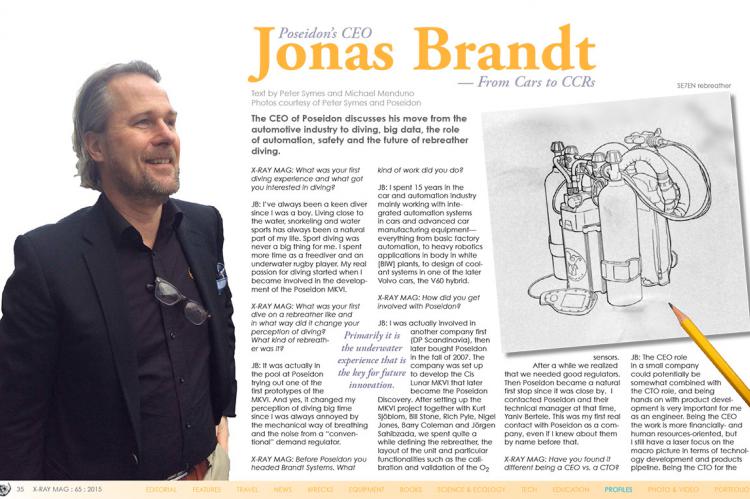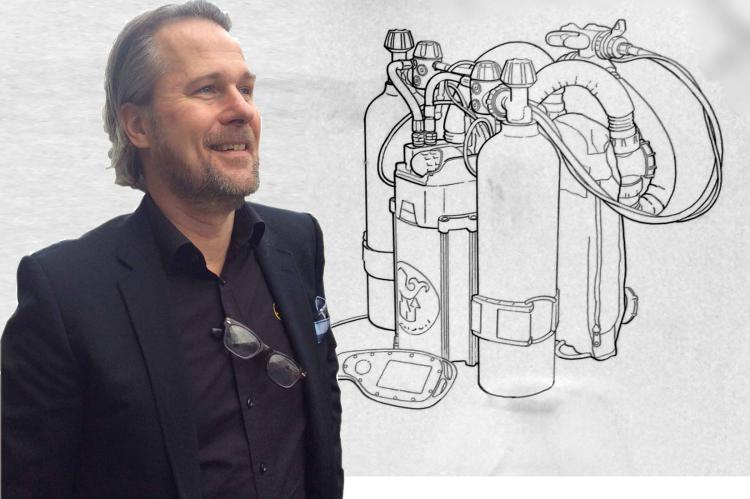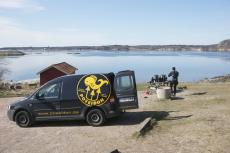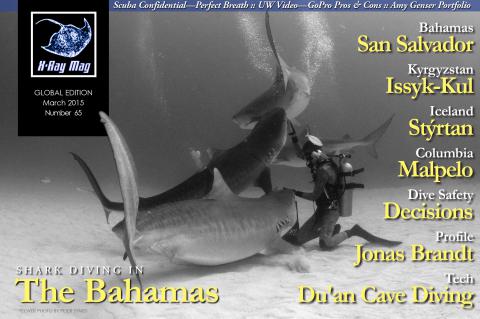Jonas Brandt—From Cars to CCRs
The CEO of Poseidon discusses his move from the automotive industry to diving, big data, the role of automation, safety and the future of rebreather diving.
Tags & Taxonomy
"I want to give divers the time to think before they act, based on the huge task load under water. But primarily it is the underwater experience that is the key for future innovation."
— Jonas Brandt
X-RAY MAG: What was your first diving experience and what got you interested in diving?
JB: I’ve always been a keen diver since I was a boy. Living close to the water, snorkeling and water sports has always been a natural part of my life. Sport diving was never a big thing for me. I spent more time as a freediver and an underwater rugby player. My real passion for diving started when I became involved in the development of the Poseidon MKVI.
X-RAY MAG: What was your first dive on a rebreather like and in what way did it change your perception of diving? What kind of rebreather was it?
JB:It was actually in the pool at Poseidon trying out one of the first prototypes of the MKVI. And yes, it changed my perception of diving big time since I was always annoyed by the mechanical way of breathing and the noise from a “conventional” demand regulator.
X-RAY MAG: Before Poseidon you headed Brandt Systems. What kind of work did you do?
JB: I spent 15 years in the car and automation industry mainly working with integrated automation systems in cars and advanced car manufacturing equipment—everything from basic factory automation, to heavy robotics applications in body in white (BIW) plants, to design of coolant systems in one of the later Volvo cars, the V60 hybrid.
X-RAY MAG: How did you get involved with Poseidon?
JB: I was actually involved in another company first (DP Scandinavia), then later bought Poseidon in the fall of 2007. The company was set up to develop the Cis Lunar MKVI that later became the Poseidon Discovery. After setting up the MKVI project together with Kurt Sjöblom, Bill Stone, Rich Pyle, Nigel Jones, Barry Coleman and Jörgen Sahibzada, we spent quite a while defining the rebreather, the layout of the unit and particular functionalities such as the calibration and validation of the O2 sensors. After a while we realized that we needed good regulators. Then Poseidon became a natural first stop since it was close by. I contacted Poseidon and their technical manager at that time, Yaniv Bertele. This was my first real contact with Poseidon as a company, even if I knew about them by name before that.
X-RAY MAG: Have you found it different being a CEO vs. a CTO?
JB: The CEO role in a small company could potentially be somewhat combined with the CTO role, and being hands on with product development is very important for me as an engineer. Being the CEO the work is more financially- and human resources-oriented, but I still have a laser focus on the macro picture in terms of technology development and products pipeline. Being the CTO for the company has been the most challenging work ever, trying to transform a nearly static business and drive innovation towards a paradigm shift in terms of equipment use, has been a great pleasure, combined with huge challenges—especially in terms of very conservative divers, used to diving in a particular way. For me, change and evolution is always good.
X-RAY MAG: You mentioned you have a background in the automotive industry. What techniques and principles can and should be transplanted to the dive industry?
JB: We take a lot of the technology around us today for granted. We have anti-spin regulation, traction control and ABS [anti-lock braking system] as integral parts of our cars today, compared to 20 years ago. When you drive your car today, do you really consider that several computers actually are in control and assist you in terms of steering, braking and controlling the car?
The evolution in cars has been huge; it is almost impossible today to even open the engine compartment and do something by yourself.
I want to transfer this philosophy into diving, so divers are given the same kind of support when something is happening when it’s not supposed to. I want to give divers the time to think before they act, based on the huge task load under water. But primarily it is the underwater experience that is the key for future innovation. I believe that with the MKVI and the SE7EN, Poseidon has taken the first step into autonomous diving, and we will continue down that path without taking the diver out of the equation.
X-RAY MAG: What other industries or businesses can we learn from?
JB: I’ve spent a lot of time looking at the aviation and car industry in terms of development cooperation. Most of the dive manufacturers are small and have limited budgets. To drive the dive industry forward, I’m certain that all manufactures could potentially win by cooperating around non-intellectual property-related technologies especially in rebreathers. Sometimes I believe that the dive industry is too small for its own good.
One of the greatest inspirations right now is Elon Musk, CEO of Tesla, who recently released all [electric car patents] to all other car manufacturers to use, only to drive the paradigm forward quickly. I see lots of similarities in between electric cars and sports rebreathers. The buyers are skeptical, the cost is higher, the infrastructure is not in place and the user behavior is different. It takes a strong entrepreneur with stamina to drive these kinds of cases—just like Poseidon
X-RAY MAG: Do you have any role models, and from where do you get your inspiration and best ideas?
JB: My creativity comes from other places than the office. I normally get most of my inspiration when I’m out sailing in summer time. Obviously the interaction with customers and research and development staff is a great source for ideas and inspiration as well. I’m a hands on guy, with a strong feeling for what might trigger people in terms of technology and market, and I like speedy controlled processes; we get an idea in the company, we solid-work it, and then we start to build it, versus a vision-to-mission process.
X-RAY MAG: There are a several major features on the Poseidon rebreather that represents a significant deviation from mainstream thinking most notably the sensor configuration. For example how did departing from the dogma of three sensor voting logic come into the picture? Would you say that Poseidon has fostered a work culture of thinking out of the box?
JB: I think that thinking outside the box is very Scandinavian. The level of freedom within Swedish companies, at least, gives everyone with an idea the chance to do some trial and error, without any fears. That builds a very special company culture where innovation is a key driver. Building a sensor calibration and validation system for O2 sensors was indeed more challenging than innovative. It was just a different approach in doing things. Calibration of sensors is nothing new, but to provide a means to do it automatically during start up was.
X-RAY MAG: One of your innovations is the blackbox/data logger on your units. I understand it collects massive amounts of data. Users can then upload their data to a central database. How much data have you accumulated? What have you been learning from all this data? Any trends? Surprises? Revelations?
JB: The amounts of data that we log in the units are huge and are a key to be able to understand how people dive with our products. We log strictly dive data and no personal data to respect privacy laws, etc. I would say that we are most likely the Google of diving in terms of the amount of data we have on our servers right now. Currently, our database is measured in hundreds of millions of events, and we log about 30 events per second during a dive. To be able to analyze and quantify data is probably one of our best product development tools.
X-RAY MAG: I understand that you share this data with DAN. Are other rebreathers manufacturers doing this too? What has been done with this data to date? What has been learned?
JB: We have proposed the sharing of data to DAN, as early as the Rebreather Forum 3 in 2012, but DAN has not really been keen on hosting the data, so it’s a continual process to find the right host.
X-RAY MAG: What are the current trends? Who is actually buying rebreathers, and is it the same groups that you first expected?
JB: Right now we see end consumers walking into our dealers buying SE7EN rebreathers. Previously, the main customer base has been instructors. We peaked in terms of sold units during 2012, then 2013 was a disappointment, but we realized after a while that the instructor market was saturated with units, and instructors had to build time to get instruction going. During 2014 we have seen a 100 percent increase in terms of sold units versus 2013, which supports my first sentence that we see end consumers buying units in a much larger scale than before.
X-RAY MAG: Many dive industry people expected rebreathers to take off a lot quicker than they have. What do you see as the obstacles? Or do you think the growth path has been what it should be?
JB: Obviously training, accumulating dive hours, etc, is a hurdle that I spoke about previously, but in essence, the biggest hurdle for divers, and in particular new divers, is time. It takes quite some time to learn how to dive, and once you have set time aside, it’s not even sure that you find yourself comfortable diving. Compared to other sports such as skiing, tennis, etc, the bar in terms of time and money is much higher. I believe technology is something that can change this pattern and drive the business forward. The business needs to evolve and not kill itself by only competing with price. We need to see new types of breathing equipment and breathing systems being born, such as the Poseidon MKVI or SE7EN, for the business to survive long term.
X-RAY MAG: Recreational rebreathers have come a long way. What do you see as the main upcoming challenges to make them even more mainstream? Is it mainly a question of marketing, technology or economy?
JB: We need to simplify and develop a system that enhances the experience and provides breathable gas in a reliable way to the diver without compromising safety. In terms of safety, we have come a long way, but there are still hurdles to overcome without adding complexity. The economy is important but not as important as we think, compared to bicycling where we see a boom due to carbon fiber entering the sport market in a similar way that tennis evolved years ago. In marketing terms, the biggest challenge will be to attract new young divers.
X-RAY MAG: To date, the incident rates on rebreathers have been significantly higher than open-circuit diving (see Rebreather Forum 3). Is rebreather diving safety improving, staying about the same or decreasing?
JB: This is something that we do not know for sure since we do not have accurate data from all manufacturers in terms of numbers of conducted dives. A joint database of just numbers of logged dives from all manufacturers would be a good start. In terms of safety, we took a huge step forward and launched new technology for sensor monitoring (auto calibration and validation). Unfortunately, parts of the dive industry met this with skepticism. Again, divers desire to be able to manipulate and do everything by themselves in a task-loaded environment, rather than breathing in an almost autonomous system which makes decisions—advice on what divers should do must be the correct thing to do. Ultimately, we would like to give the diver more time to decide what to do next rather than [having to act immediately] NOW.
X-RAY MAG: An operator recently stated to me that while he was otherwise interested in becoming a rebreather-friendly operation, the lack of common standards between brands of rebreathers made stocking the various spares and different consumables both a logistical nightmare and economically unfeasible. How can this issue be minimized, and is it something on which you can collaborate with other brands?
JB: I was one of the founding members of RESA [Rebreather Education and Safety Association], and my ultimate target for a manufacturers’ organization was to drive standards in terms of commonalities in between the units—the same cylinders, valves and scrubber would have been a great step forward. Unfortunately, RESA has been working solely with training standards and legal questions based on U.S. law interpretation. We need to get to a situation where the ‘throttle and the brake’ are the same on all units.
X-RAY MAG: Is it possible to build a fully automated don-and-dive rebreather, and how far off are we from that becoming a reality?
JB: We already built one, if you ask me. There are, of course, functions in the SE7EN that can be optimized, but yes, I do believe that we built what you are referring to.
X-RAY MAG: How far should we take automation in diving? Don’t we risk introducing complacency in the user at some point?
JB: Complacency is probably one of the most pressing issues in diving, generally speaking. We need to automate the use of aviation standard checklists. Don-and-dive has obvious drawbacks, but ultimately, we need to come to a place where responsible divers are honored and become role models.
X-RAY MAG: How do you see the future of diving? What do you see as the main challenges and opportunities ahead? Have your visions changed, and if so, in what manner have they been refined?
JB: Our vision is still the paradigm to have people exchanging their old open circuit equipment to closed circuit rebreathers, but in the end the industry needs to be more innovation across the board, to be profitable. It’s hard to reveal the whole product pipeline in an interview, but frankly, the vision has been intact over the years. However, the strategy to reach our targets has been refined and altered many times.
X-RAY MAG: What are your personal hopes, goals or aspirations for Poseidon’s rebreather business? What will the business look like in five years? Ten years? Twenty years?
JB: I see a fast growing business in the next five years, with about five to ten percent of all new certificates issued being on rebreathers. I believe that at least ten percent of divers will dive rebreathers in ten years’ time.
X-RAY MAG: And how about you? Any personal hopes, goals or aspirations with regards to diving?
JB: Not really. My goal is to make Poseidon the driving force behind the paradigm shift from OC [open circuit] to ECCR [Electronic Closed Circuit Rebreather] and build our brand even stronger in other areas than just rebreathers, in the next couple of years. It’s very easy to become blindfolded, focusing on one new product and forgetting about the long heritage Poseidon has in terms of inventive and high performace products outside the product group of rebreathers. In terms of diving, then it has to be something like: “Work less, dive more.” ■
For more information, visit: www.poseidon.com
Download the full article ⬇︎

Originally published
X-Ray Mag #65
Diving with tiger sharks in the Bahamas; San Salvador Island; Ancient remains in Kyrgyzstan's Lake Issyk-Kul; Iceland's hydrothermal vents at Stýrtan; Malpelo Island; Wreck diving on the HMS Warrior II; Dive safety decisions; PFO & diving; Poseidon's CEO Jonas Brandt profile; Cave diving in China's Du'an county; Scuba Confidential on the perfect breath; A case for unsweetened tea; GoPro's pros & cons; Amy Genser portfolio; Plus news and discoveries, equipment and training news, books and media, underwater photo and video equipment, shark tales, whale tales and much more..
.































